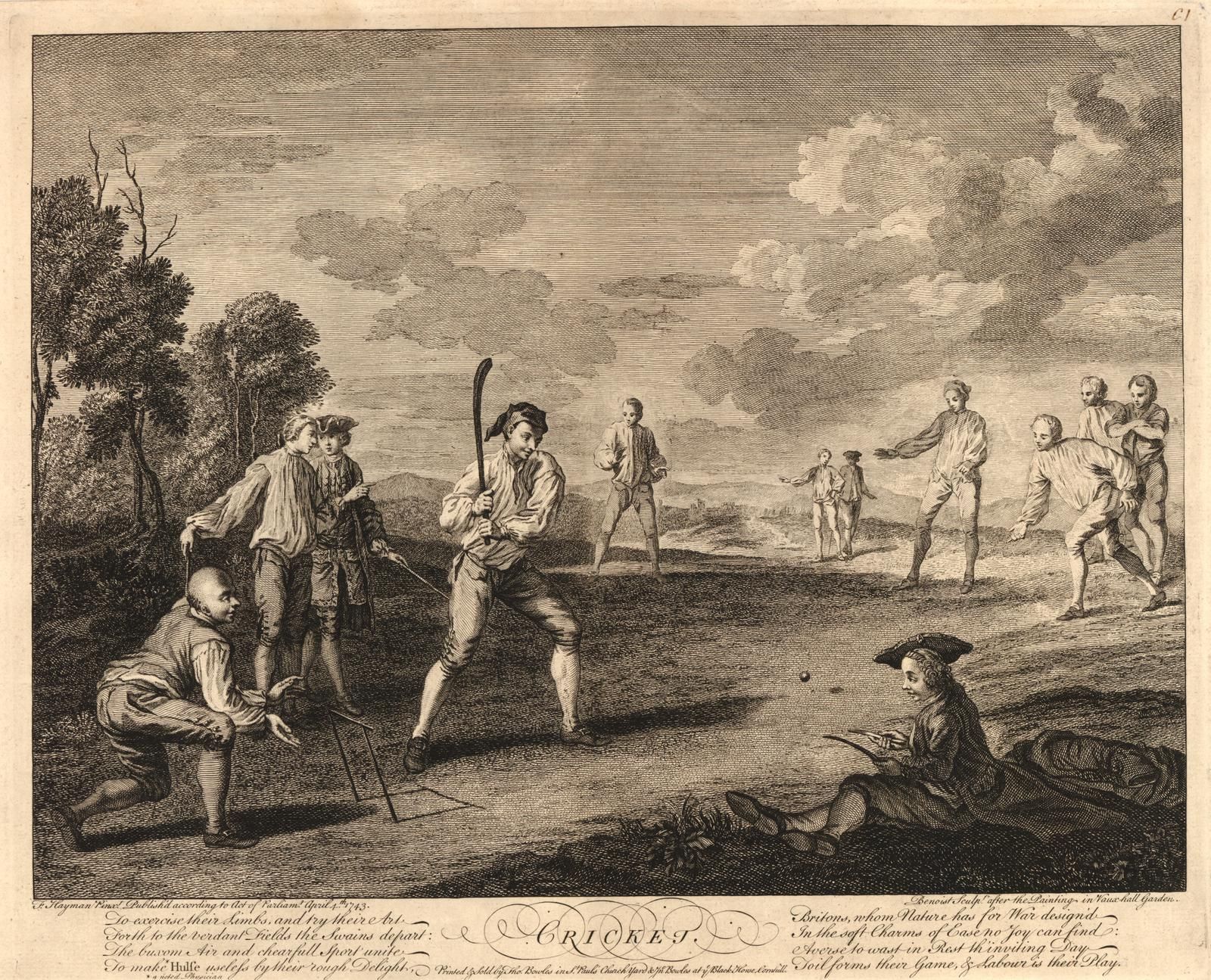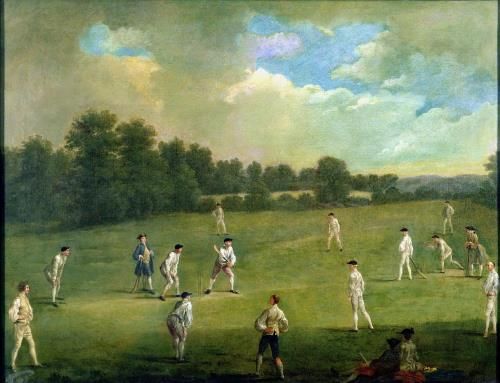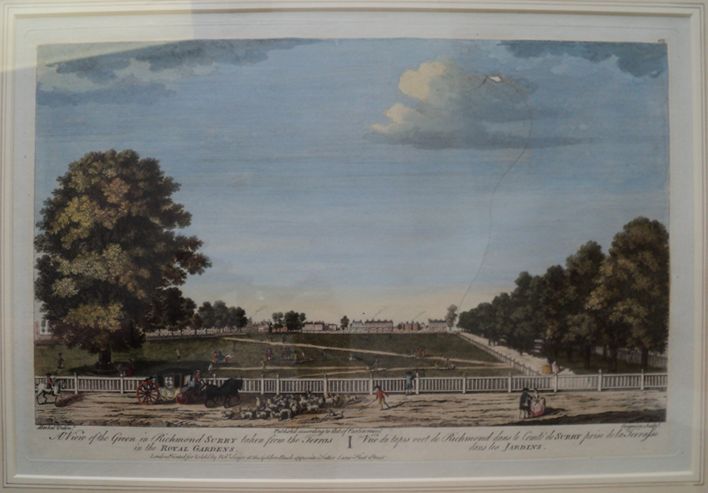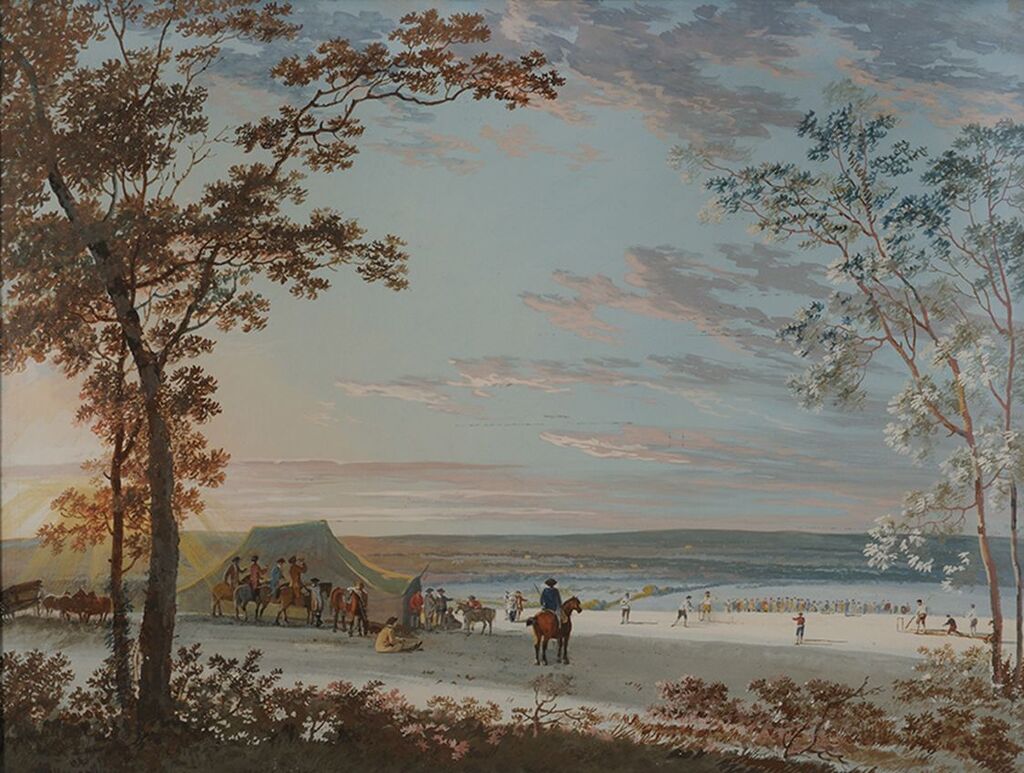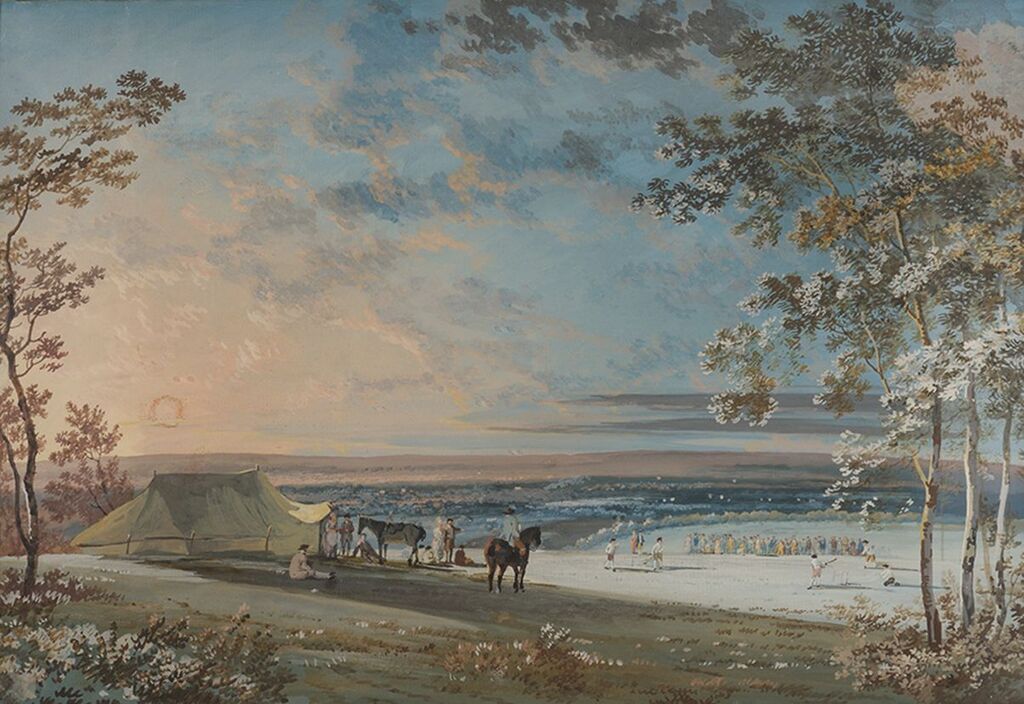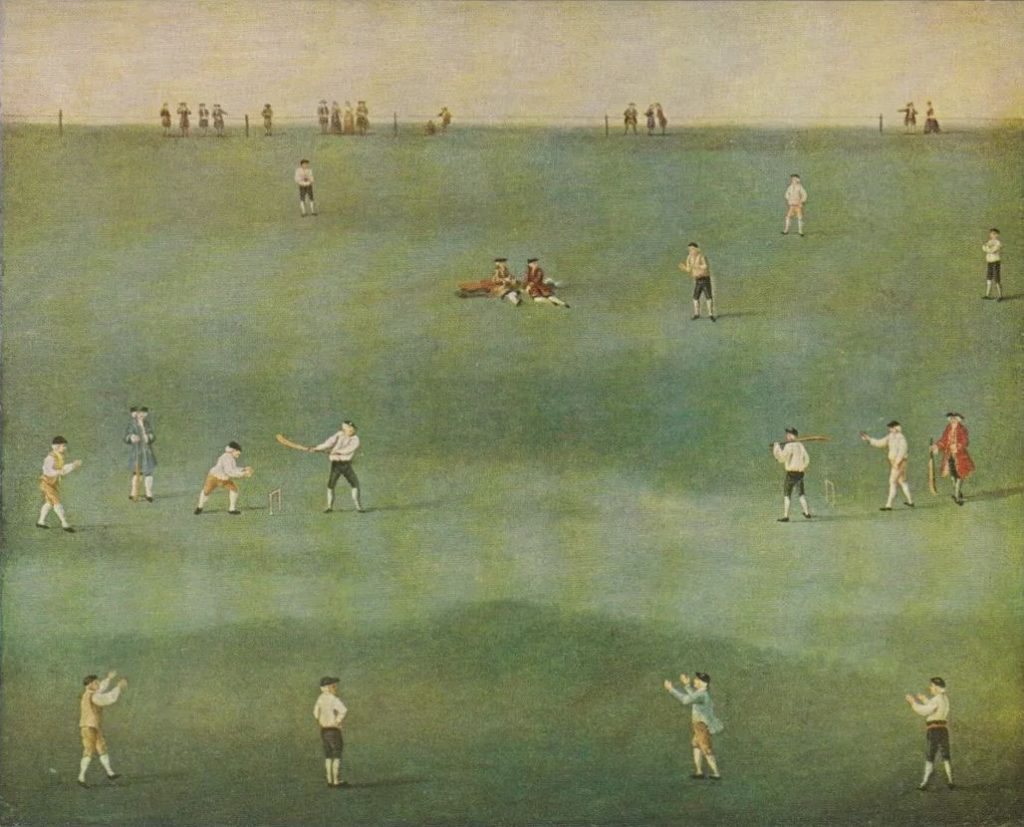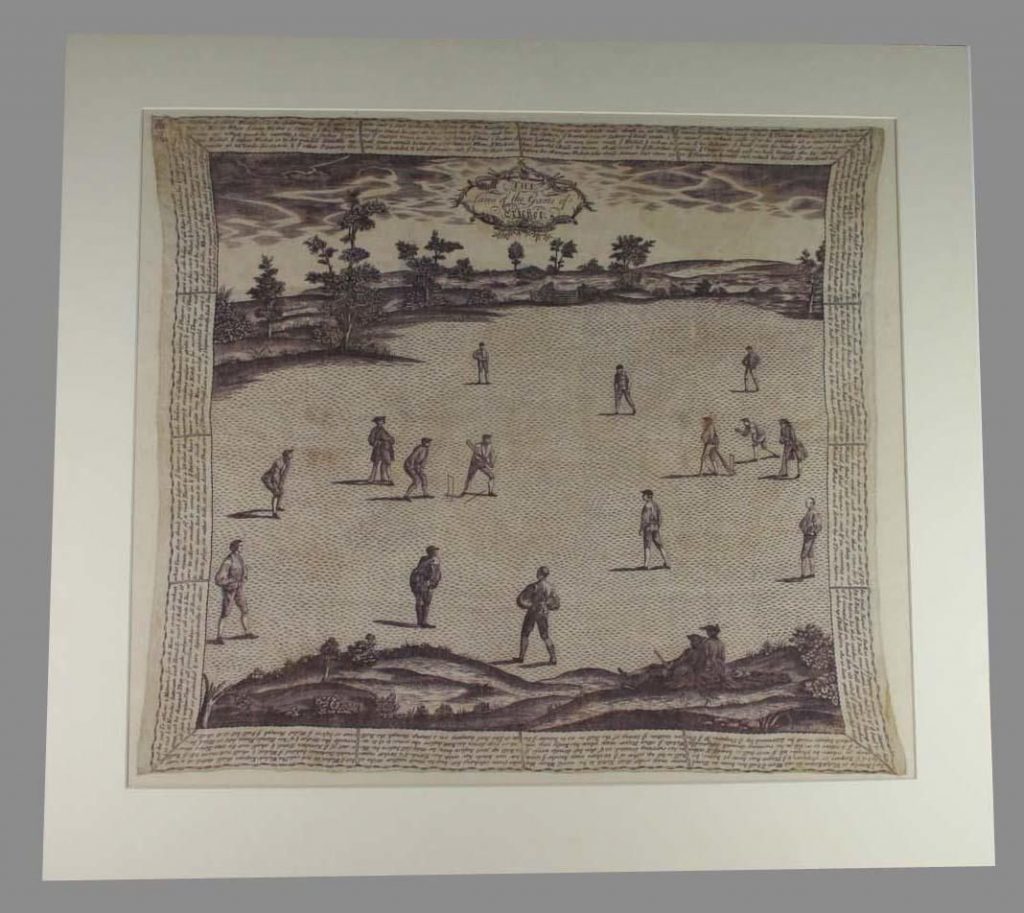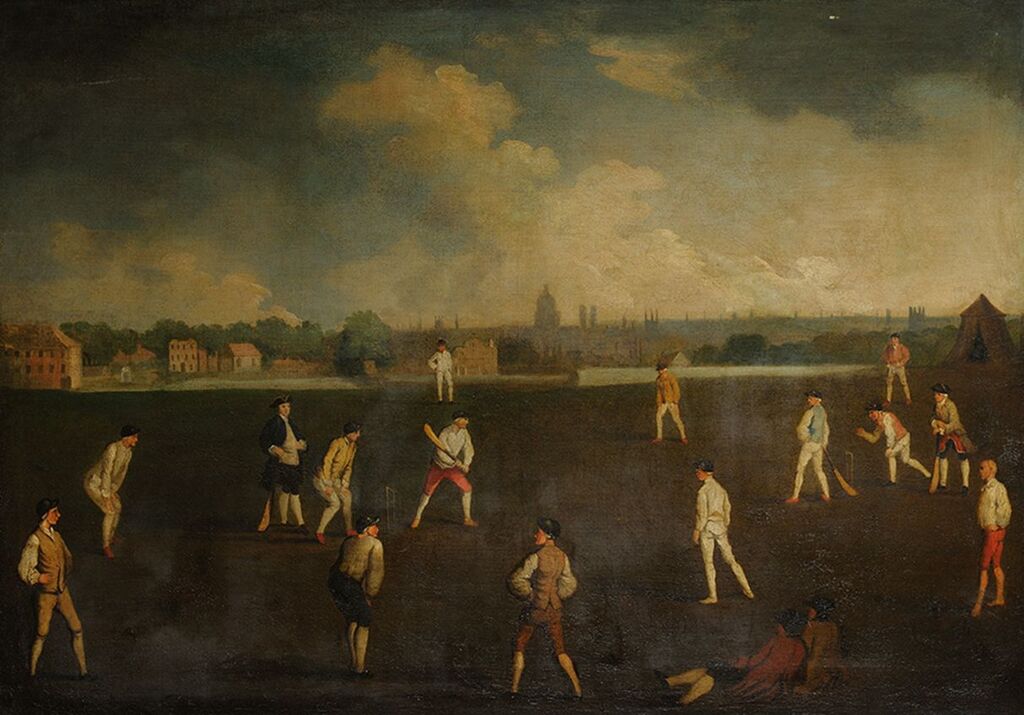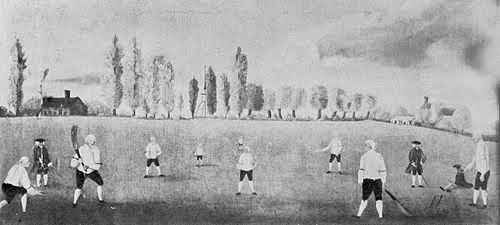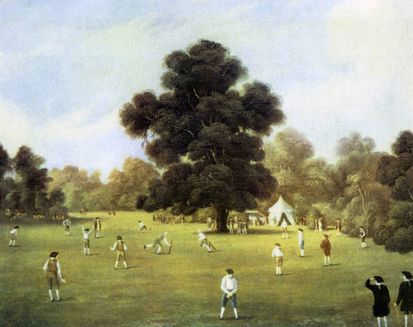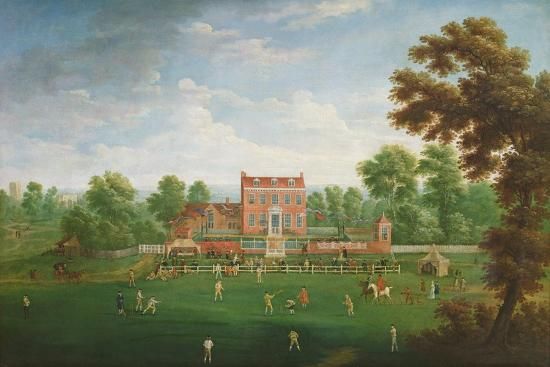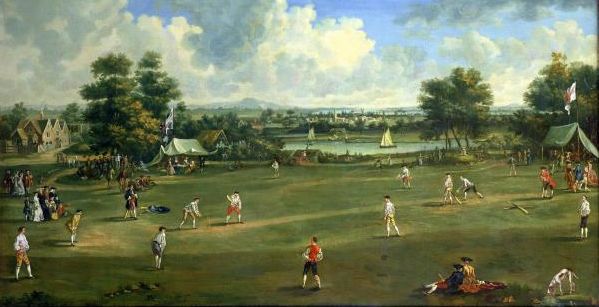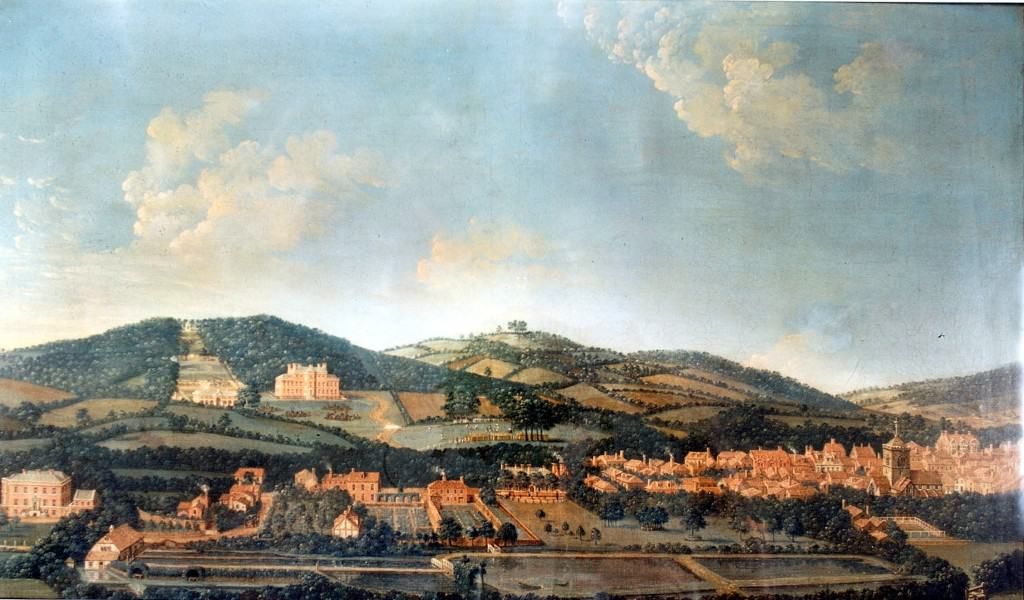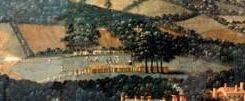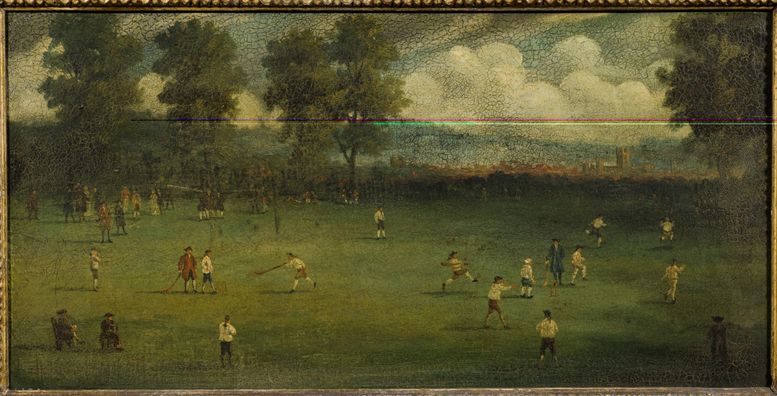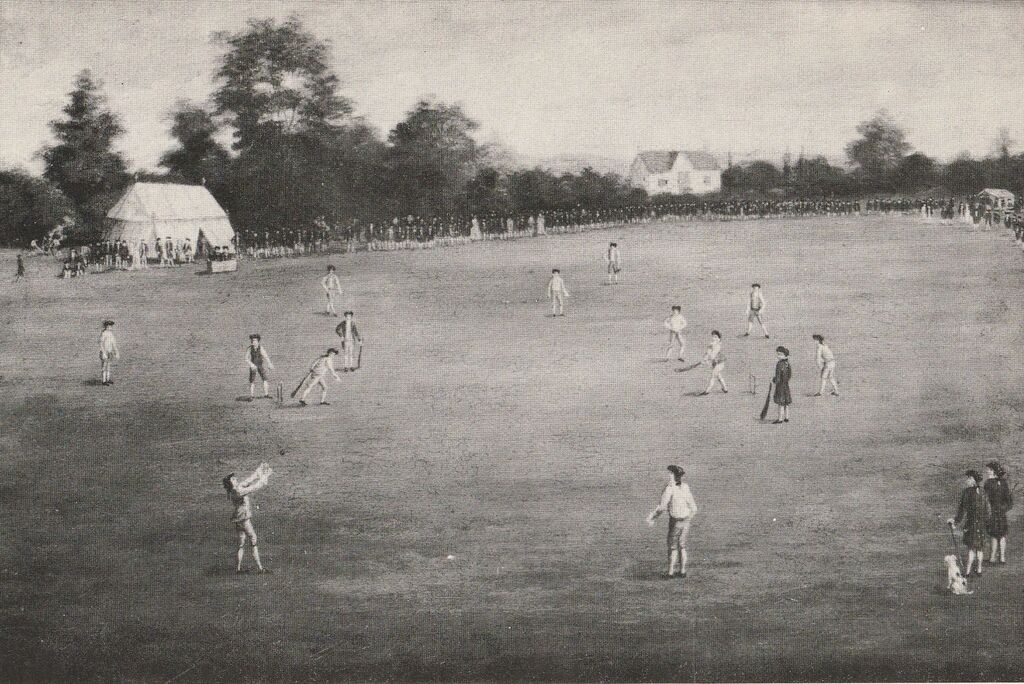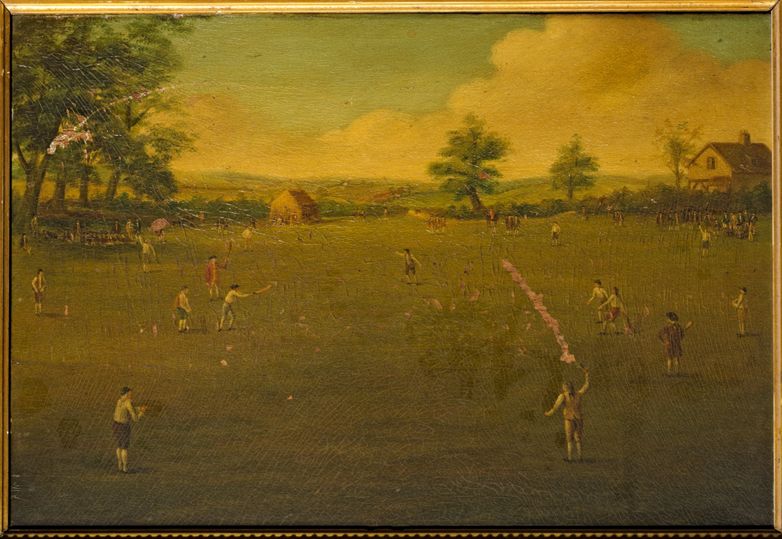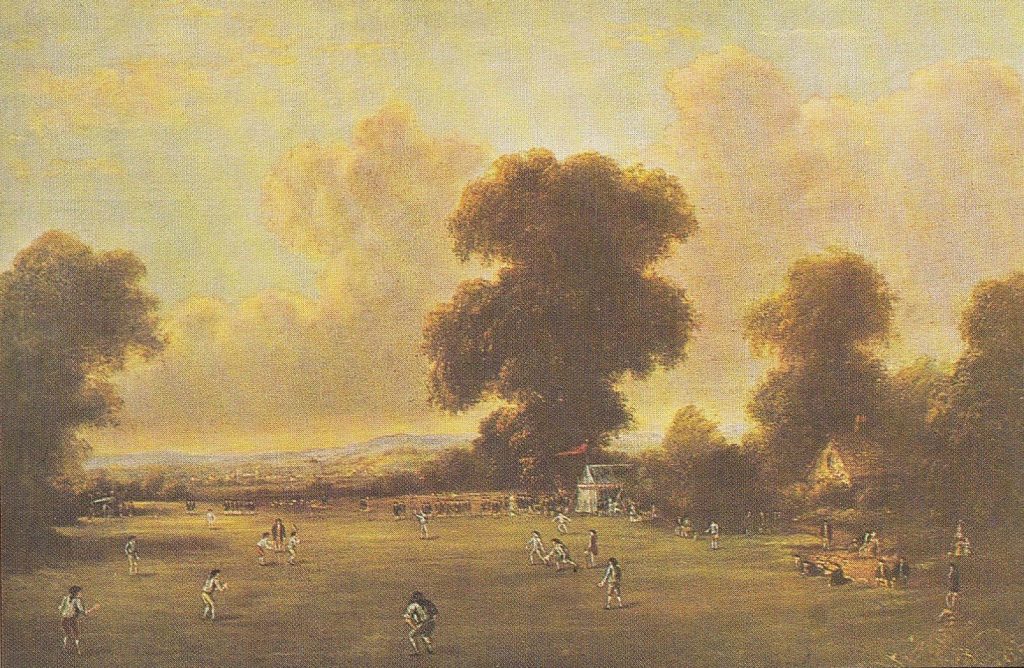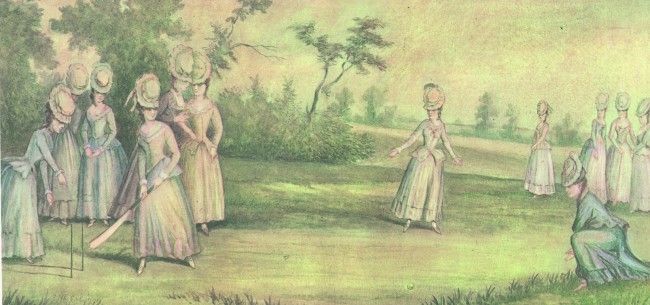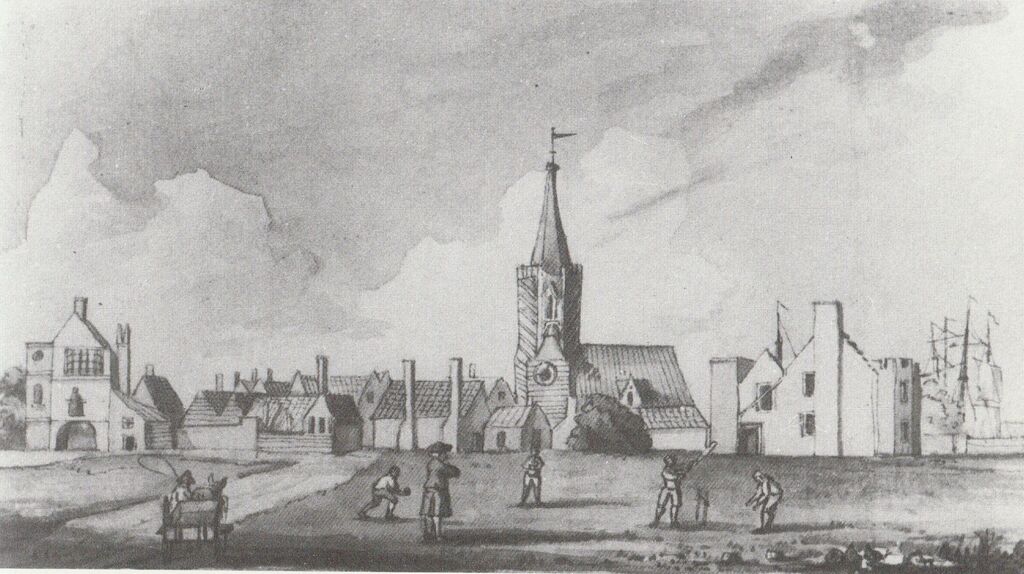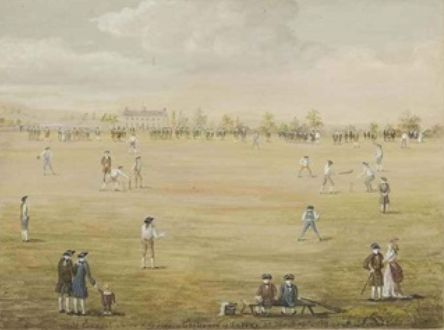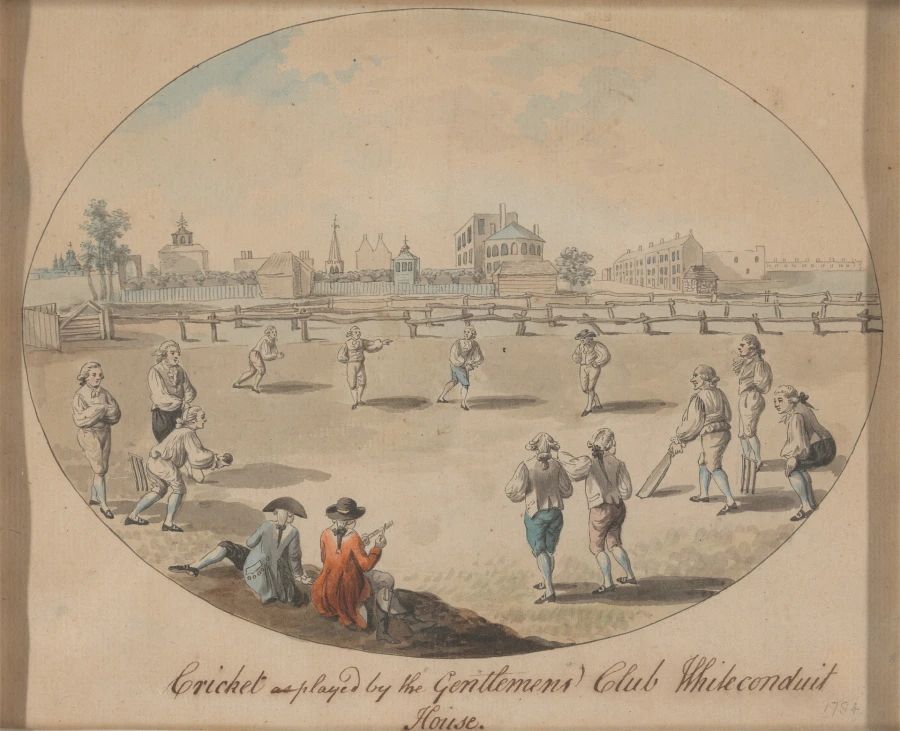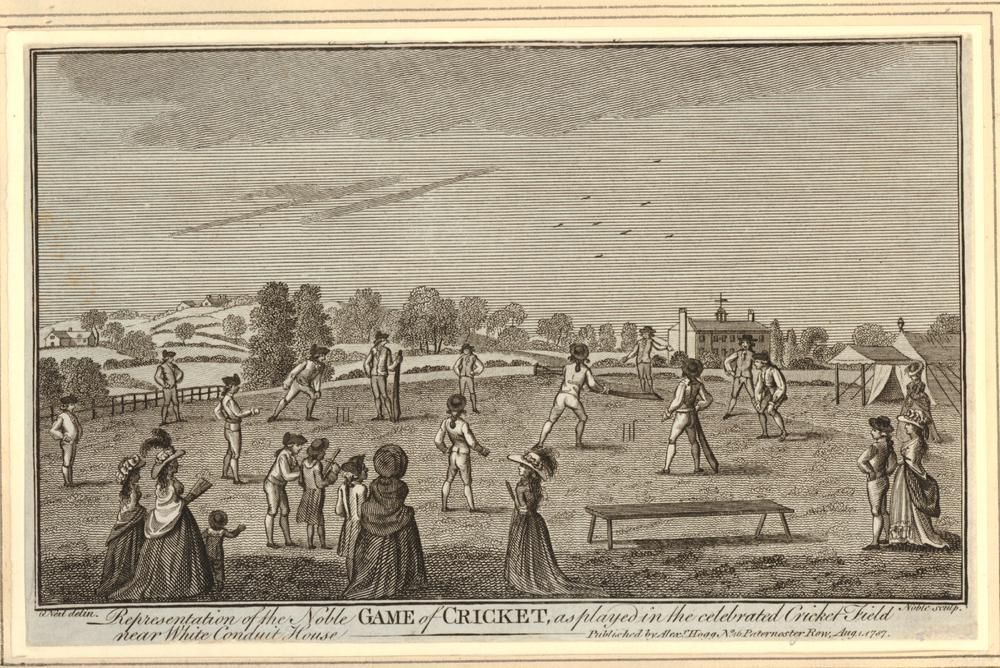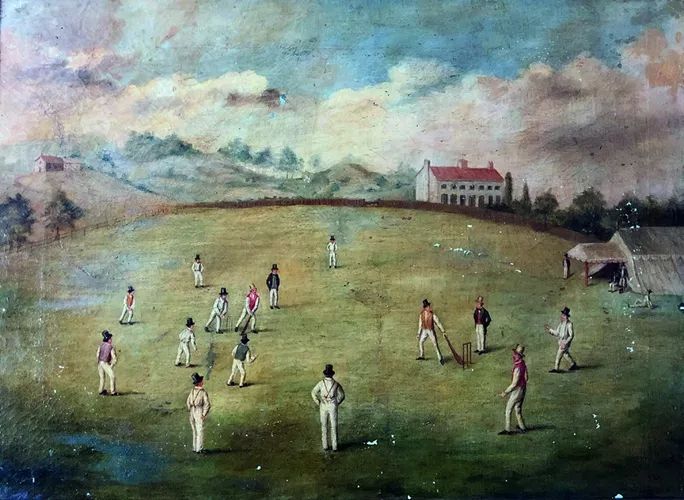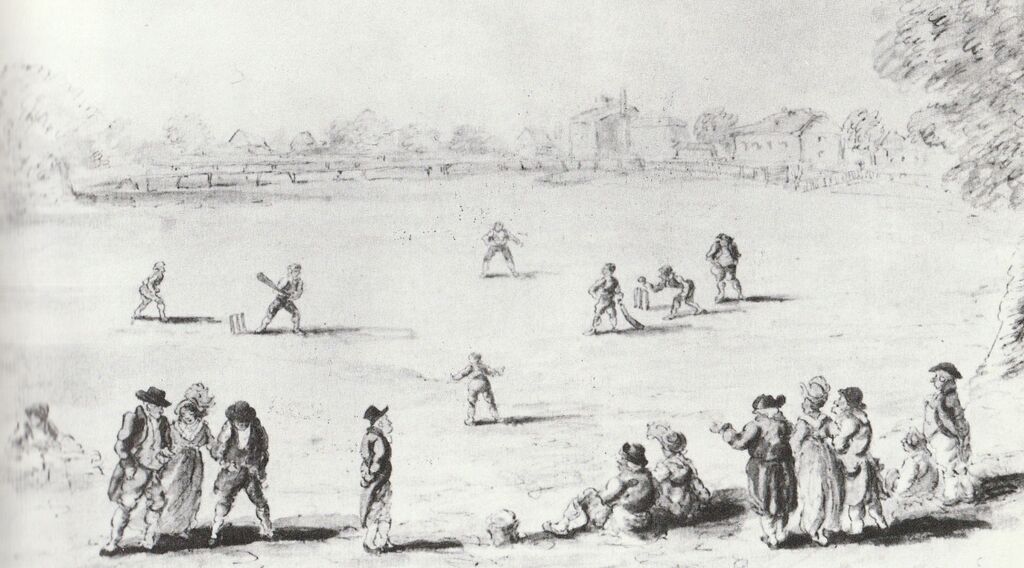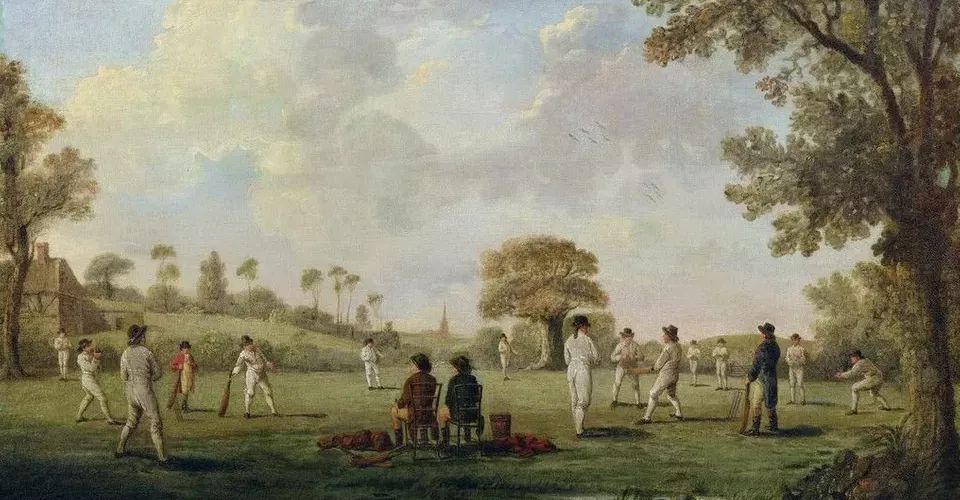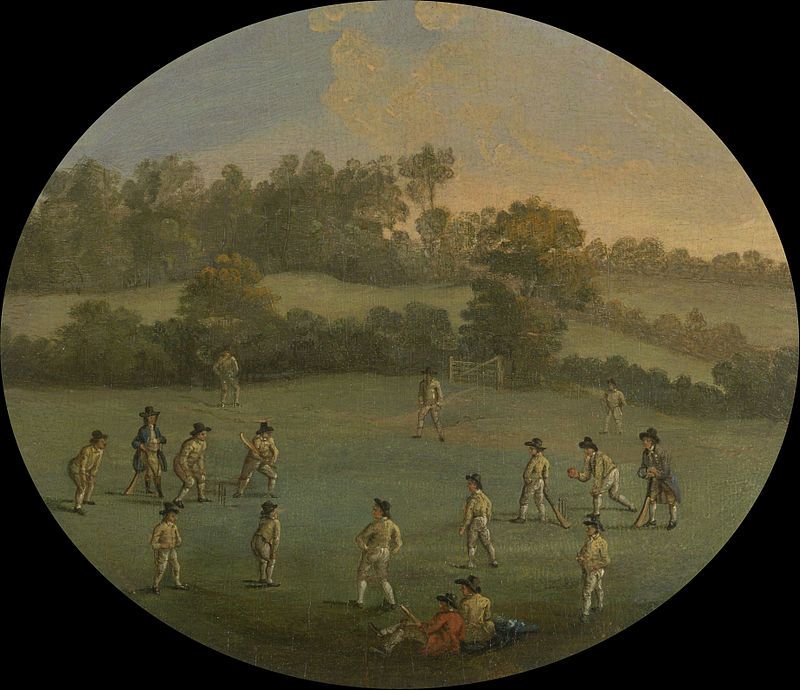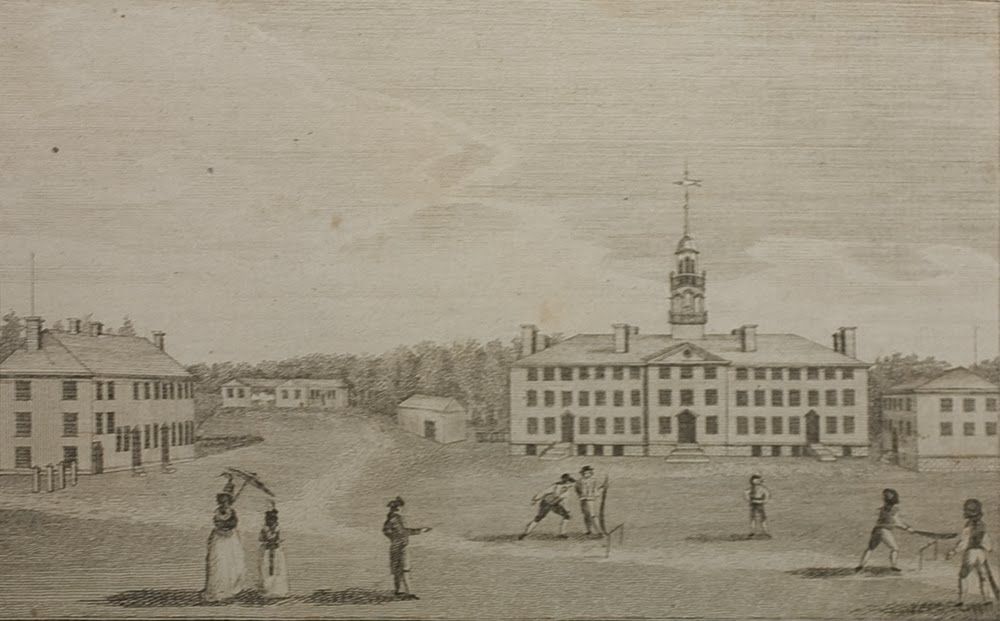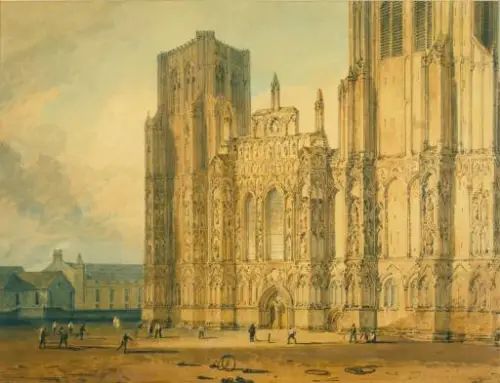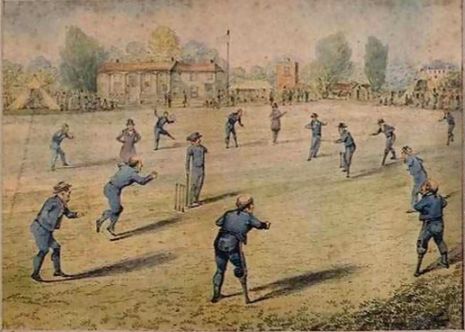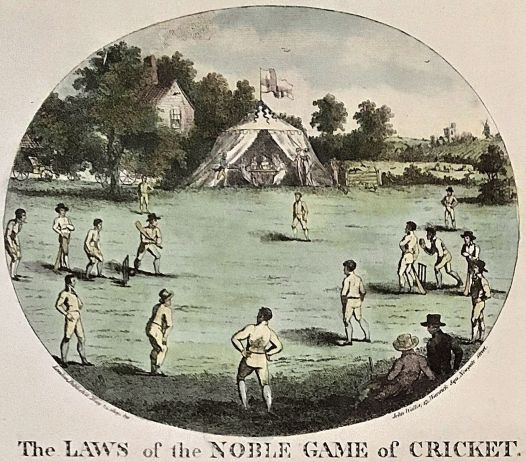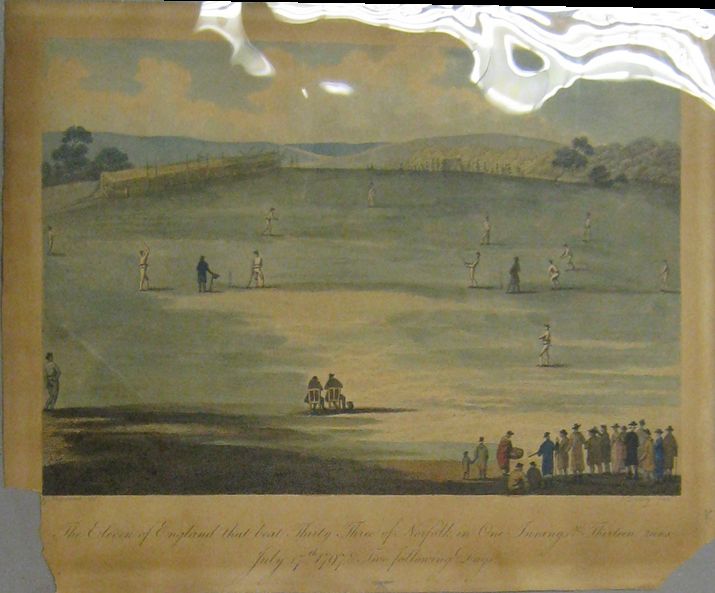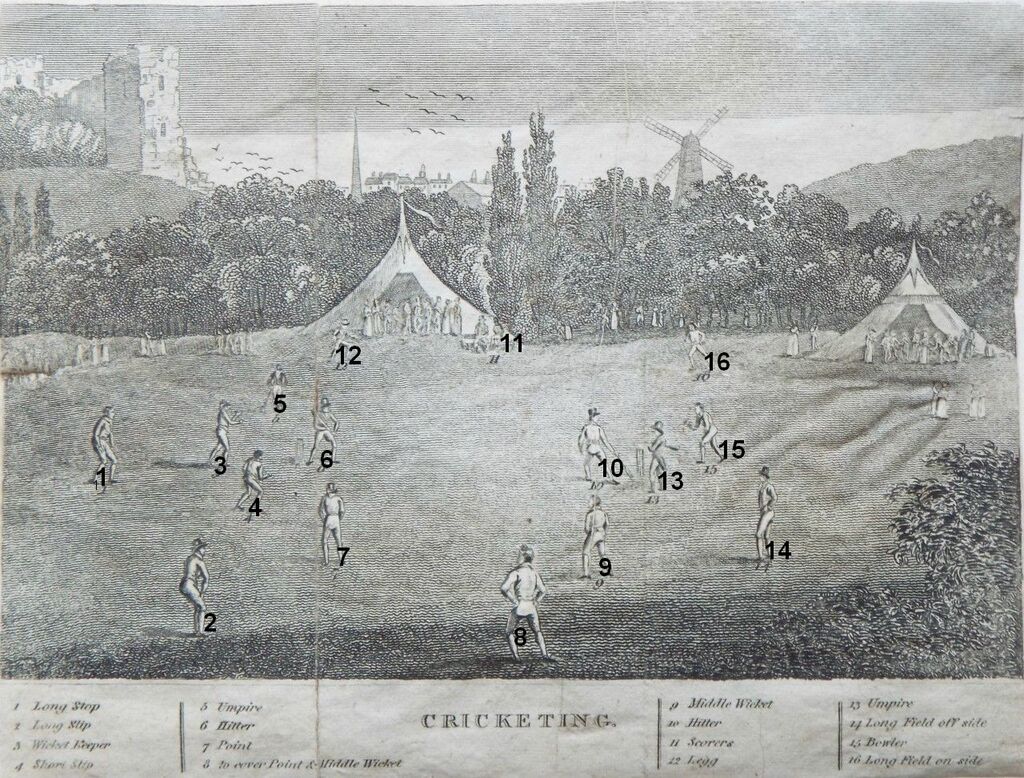Contents
1743 – Cricket as played at the Artillery Ground – Benoist, after Hayman (1735)
An engraving by C. Benoist, after an Oil painting by Francis Hayman, RA, based on the earliest depiction of a cricket match that we know of; obviously, this is a very important artwork and one that is much copied. The original by Hayman is now lost but used to hang in a supper-box at Vauxhall Gardens (opened 1735).
The painting has come to be known as Cricket at the Artillery Ground, but this is a misnomer. The picture was originally described as A Game of Cricket as played in the Artillery Ground, the Ground of the Honourable Artillery Company being the most famous of its day, and the misunderstanding arose from that. In fact, the Artillery Ground was walled in, so this picture is obviously somewhere else. Note, this is a single-wicket match; there is only one wicket and one batsman. Also, the hockey-stick style bat is being used
The verse under the picture reads:
To exercise their Limbs and try their Art
Forth to the verdant Fields and Swathes depart
The buxom Air and cheerful Sport unite
To make Hulse* useless by their rough Delight
Britons, whom nature has for War design'd
In the soft charms of Ease no Joy can find:
Averse to wast in Rest th' inviting Day
Toil forms their Game and Labour is their Play.
* I have no idea what this word means.
1740 – A Cricket Match at Mary-le-bone Fields – Hayman
A hugely important painting by Francis Hayman, the original survives in the MCC collection. Oil on canvas 88 x 108 cm. Mary-le-bone Fields is the site of Regent’s Park, though whether the picture shows that location is not certain.
Simon and Smart refer to this picture’s “high quality and subtle handling” and say it is “a painting of high quality which has been surprisingly neglected in the literature and to which we now give an overdue place of honour”1
The arrangement of figures in this painting is reproduced many times in the other paintings on this page. Further consideration of the image is given here.
1740 – A View from the Green in Richmond – Heckel
Coloured line engraving of Richmond, Surrey, view of the Green, taken from the terrace in the Royal Gardens. A game of cricket is in progress on the green. Published by Robert Sayer, Fleet Street c.1752.
1743 – Landscape with Cricket Match in Progress – Paul Sandby
Possibly in Yorkshire. It has a distinct wintry appearance, arising from the frosty-looking grass – no doubt, misleading. But very atmospheric.
1743 – An Exact Representation of the Game of Cricket – after an engraving by Louis-Phillipe Boitard
Possibly by WR Coates. The arrangement of the fielders echoes Hyman, note especially double-teapot man in the covers, but four leg-side fielders rather than three. The scorers are on the far side of the field but still positioned well within the field of play, this seems to have been a common feature of cricket of the time.
The painting is in Tate Britain. See article in The Independent.

This ticket is for England v Kent (1744) at the Artillery ground and is obviously derived from Boitard.
1744 – Handkerchief of the Laws of Cricket
The picture is a straightforward copy of Hayman; the importance of this object is that, around the edges, are the first laws of cricket we have.
1750 – Cricket in Battersea Fields
View of London in the distance with many steeples and churches evident. Again, the figures are clearly derived from Hayman, three leg side fielders plus double-teapot-man.
1750 (?) – Cricket at Sevenoaks
I know very little about this rather basic engraving, it appears as an illustration in EV Lucas’s book, The Hambledon Chronicles. The size of the players in relation to the size of the ground is rather strange
The building on the boundary looks like the workhouse behind the White Conduit Ground (see below, 1790). From the layout and attitudes of the players, though, it seems to be derived from Hayman.
1750 (?) – Cricket Match
1755 – Knowle Park
Lords and Gentlemen of Surrey and Kent playing cricket at Knowle Park, Kent, 1775. Artist not known.
c1760? – A Cricket Match at Kenfield Hall, near Petham, Canterbury in the 18th Century – George Morland
The location was confirmed by cricket commentator Brian Johnston, once a resident of Kenfield. Spectators stand in the garden behind a white fence. A banner with ‘Welcome’ written on it hangs from the wall behind them.
The cricket match in the foreground gives way to the artist’s fascination with the nuances of light and the contrasting weather conditions, the cricket pitch is half in sunlight, half in shade, created by the dark clouds and silhouetted oak tree, right.
1761 – Cricket at Brading, Isle of Wight
The cricketers are wearing red, gold or blue breeches. Tents with the Union flag on the left and St George’s flag on the right. The arrangement of figures is similar to Hayman (1740); this painting may be a nineteenth-century pastiche.
c1770 – A Cricket Match on Cotmandene, Dorking – James Canter
View of the town of Cotmandene, near Dorking, with a cricket match in progress in the centre of the painting, merging into the landscape. On the left side is Deepdene, at the time the home of James Howard, 11th Duke of Norfolk. Despite its inconvenient slope, Cotmandene continued to be the main venue for cricket in Dorking well into the 19th century, until the establishment of a new ground at Pixham in 1878. The last recorded match at Cotmandene took place in July 1899, between Dorking and an MCC side featuring the novelist Sir Arthur Conan Doyle.
1770 – Cricket at Wincheap, near Canterbury
Players running between stumps. Canterbury Cathedral and town in the background.
This is not the current Kent Ground, known as St Lawrence, although this is also in the Wincheap area.
1773 – Kent v Sussex, Sevenoaks Vine
What I love about this painting is that there is genuine action. The bowling has to be from the left of the picture, with a largely offside field. The leg-side fielder, at what we would now call cow-corner, is poised to take a catch; you can just see the ball close to his hands as he lines himself up. The batsman is rooted to his crease as he awaits his fate. Strangely, though, the bowler seems to have disappeared – he must be the chap behind the stumps who seems to be waiting for a return throw.
1773 – Title page illustration from Surrey Triumphant
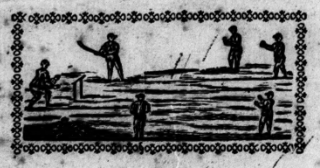
A simple illustration for a famous poem.
1774 – Surrey v Hambledon
A cricket match is in progress on an uneven field. Players wearing breaches and holding curved bats. Oak trees and a village in the background.
The layout of the fielders seems to be the painter’s own, possibly indicating this was an authentic view. Bowling is from the right, we get a good view of the bowler’s follow-through. Strangely, the bowlers-end umpire seems to be standing at a kind of short extra-cover; the LBW law came in in 1774, around the time of this painting, but was not widely used for many years thereafter – so, the umpire would see little need to line himself up with the wicket
Possibly at Guildford Bason, Merrow Down.
1774 – Kent v Hampshire at Bishopstone – Belanger
In Kent v Hampshire, the umpire is supposedly the great Lumpy Stevens. I have, however, read of no further suggestion that he ever acted as umpire.
According to Maun, this painting is a Victorian pastiche.
1779 – The Countess of Derby and friends playing cricket – T.H.
The only pictures of Eighteenth Century Women playing cricket but in aristocratic rather than the more usual rural setting. The atmosphere is more of casual play rather than a match – most of the ladies appear to be spectators rather than participants.
1780s ? – A Village Cricket Match, with Spectators

A very interesting painting, in many ways. For one thing, it shows play from behind the batsmen rather than from mid-wicket as in every other view on this page. A second point is that there are more spectators here than in any other painting, including some in the right foreground getting stuck into the bar.
The hills in the background could easily be the South Downs. Meanwhile, the church is distinctive, with the stair turret rising above the tower. It could just possibly be The Vine, Sevenoaks, as St Nicholas church, half a mile from the ground, has a similar feature.
1784 – Harwich with a game of cricket in progress – John Nixon
Harwich is an Essex port, and tall ships can be seen in the background. That cricket should be shown as an incidental activity in Essex is another indication of the spread and popularity of the game of cricket
1785 – Handkerchief of the Laws of Cricket, with a game at White Conduit Fields
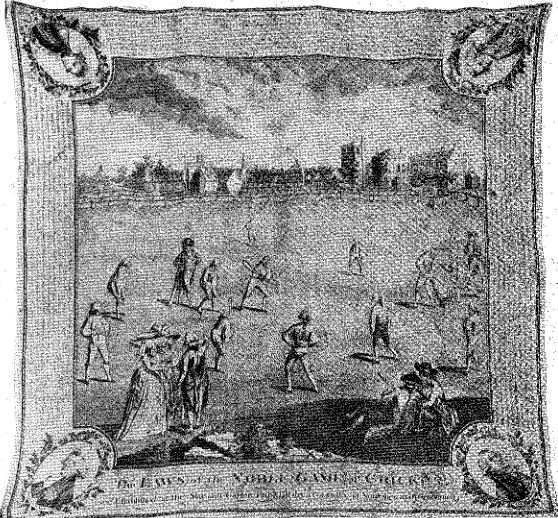
The figures from the 1744 handkerchief of the laws, themselves from Hayman’s A Cricket Match at White Conduit Fields, but now superimposed on the background of the White Conduit buildings. In the corners are four patrons of the game – Colonel Tarleton, Sir Horace Mann, Frederick, Prince of Wales and the Third Duke of Dorset.
1780s – Cricket at White Conduit Fields (1)
The first of five pictures of White Conduit Fields Ground, this one a south-to-north view. The large building in the background is the Islington Workhouse.
1784 – Cricket at White Conduit Fields (2) – Robert Dighton
This view of White Conduit Field is from the North to the South – the City of London skyline is prominent. An unusual example of a painting with several identifiable topographic details beyond the field itself. White Conduit House and Grounds were an important 18th-century leisure facility for the less well-off classes. The site of the central building is now on Penton Street, Islington.
1784 – Cricket at White Conduit Fields (3) – engraving
This is a view from South to North, away from the White Conduit building. The large building in the background is the Islington Workhouse. The low three-stump wicket, however, was never a feature of the game.
1790 – Cricket at White Conduit Fields (4) – painting
A view, very likely, based on the engraving of 1784. Note the similarity of the presentation of background features such as the cottage (left), the tent and the workhouse.
Top Hats are very prominent – these became fashionable in the 1780s.
1790 – Cricket at White Conduit Fields (5) – Thomas Rowlinson
A view, very likely, based to some extent on the engraving of 1784 by Robert Dighton, although there are several differences, for example, bowling is from the opposite end. However, the White Conduit buildings are fairly clear in the background. This picture, though, has the element of gentle caricature.
1790 – Cricket at Moulsey Hurst – James Ward
A match at Moulsey Hurst on the south bank of the Thames. The view across the river includes the church tower, the small island, Garrick’s Ait, and Garrick’s Temple to Shakespeare.
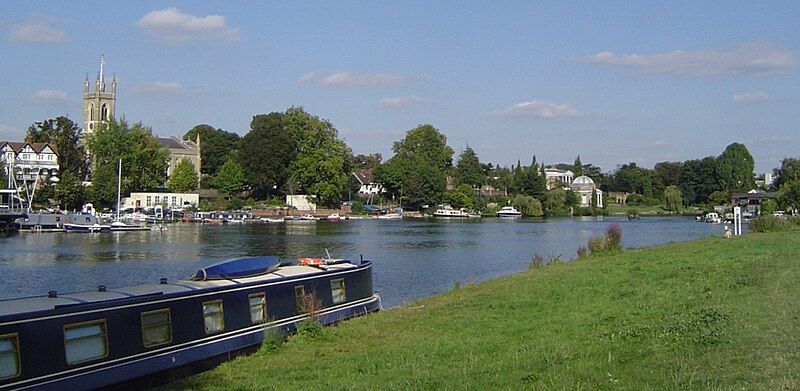
James Ward RA (23 October 1769 – 17 November 1859) was an English painter, his fame largely rests on his work as a painter of animals and as an engraver.
1790 – A Game of Cricket – Anon
A game of cricket, 1790. Sometimes associated with Hambledon, but, in truth, location unknown, certainly the steeple in the background is not visible at Broadhalfpenny Down, and neither is the cottage to the left.
The posture and clothing of many of the players, the artistic technique, the colouring, even the dimensions, are strikingly similar to the Moseley Hurst painting above. For example, look at the batters, the field settings, the players’ hats and the use of shade in the foreground. Another feature is that the bowling is from the left of the picture, in most paintings inspired by Harman, the bowling is from the right; this has the effect of placing most of the fielders (the packed off side syndrome) facing the audience instead of us seeing their backs. It seems to me that this could be the work of James Ward as well.
1790 – A Cricket Match at Chertsey in the 18th Century – George Morland
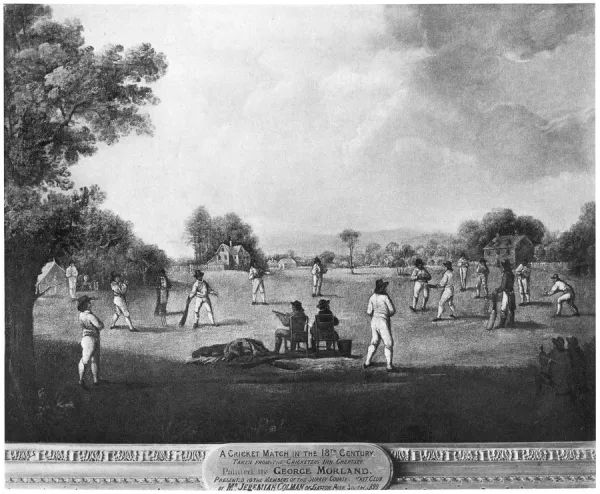
A blatant pastiche of the picture above, or perhaps the other way around. This picture, though, gives a location: ‘View from the Cricketers Inn, Chertsey’. Chertsey, though, played most matches at the Laleham Burway Ground, out of town, nowhere near an Inn. But they stopped playing there in 1787, so perhaps this is their new ground.
George Morland (1763-1804) was a prolific artist, whose work was frequently reproduced in engravings.
1790s – A Game of Cricket – after Hayman, 1740
A Game of Cricket, supposedly at The Royal Academy Club in Marylebone Fields, now Regent’s Park. Hayman’s 1740 arrangement of the cricket field is again been recycled, fifty years after it was first made. For me, this painting seems to have a more rustic air, perhaps because the background field is more prominent and a five-bar gate has been added, albeit that the third stump is in evidence. The players of both sides are uniformly attired in white breeches and short yellow jackets, an emerging fashion.
1793 – Cricket Match At Lord’s Ground In Dorset Square

A 1,000 guinea contest at the Dorset Square Lord’s Ground between the Earl of Danley’s team and the Earl of Winchilsea’s. Published in The Sporting Magazine, 1 July 1793. Notice the fence, the Gentlemen cricketers moved from White Conduit Fields as they wanted more privacy.
The two-stump wicket is unlikely. Also, the hill in the background doesn’t look like London – perhaps that is just artistic license.
1793 – Engraving of Dartmouth College, USA – Josiah Dunham
1795 – Wells Cathedral with a Game of Cricket – JMW Turner
1796 – Cricket-Match at Montpelier Gardens, Walworth – H. Alken
Played by eleven Greenwich Pensioners with one leg against eleven with one arm, in front of what seems a large crowd.
1798 – Illustration of the game attached to the laws
This image, clearly derived from Hayman, is used despite it now being archaic, especially the shapes of the bat. Three stumps are in use, though and top hats appear as well. A tent has been added where ladies appear to be taking their rest, also a cottage emerges from the trees.
1799 – Grand Cricket Match at Swaffham, Norfolk – Artist G. Shepheard, engraving by J. Dadley.
Coloured line engraving of a Cricket Match. It was published in 1799, accompanying a scorecard, and ostensibly illustrating a match at Swaffham, Norfolk July 17th 1797, between XI of All England against 33 of Norfolk. Not sure about the hills in the background – not very Norfolk-like. Incidentally, in their two innings, for 64 dismissals, Norfolk totalled 131, highest individual score being 9. All-England reached 144 in their one innings and so won by an innings and 13 runs.
Regarding the location depicted, in his book about Hambledon, The Glory Days of Cricket, Ashley Mote identifies an engraving of this picture as being Broadhalfpenny Down and the structure on the far side as being The Lodge, a kind of pavilion for spectators. He says the Lodge was erected at the start of each season and dismantled at the end, and it was also used at Windmill Down, when that became the main ground. Better research, however, shows that it was purely a Windmill Down facility, where it was also known as the Cricket House. Furthermore, it was built of brick with a thatched roof and was never dismantled, until it was finally removed, presumably when the ground ceased to stage cricket matches. A question does arise: could the picture then be of Windmill Down, and just recycled to meet the need for a cricket picture to attach to a scorecard? Certainly, the background is like the Sussex Downs. The identified engraver, J Dadley, was born in 1767, so if the picture is from the early 1790s, Windmill Down, where the last major match was 1795, it would be a possibility. Close inspection, though, indicates a small building on the boundary, just right of centre, and no such building would have been there. Also, the structure looks more like some kind of marquee than a brick building. So Mote’s ideas are probably without foundation.
1800 – A cricket match on Bansted Downs, Surrey – Belanger
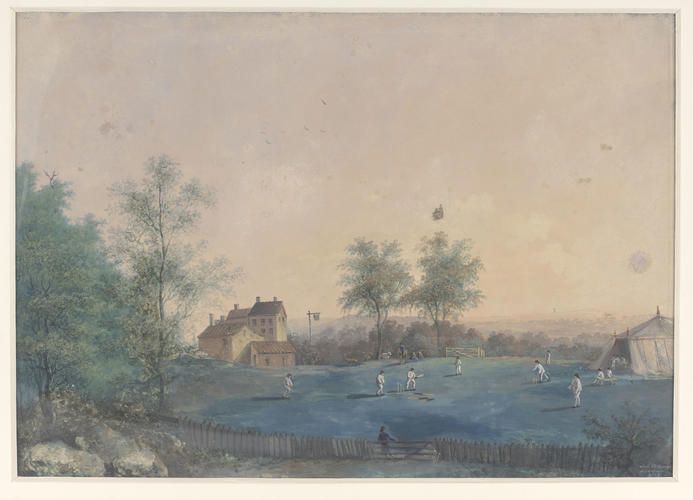
Cricketers playing in an open field, an inn to the left, open landscape in the background. This seems like a very authentic painting to me, composed from life rather than a pastiche of an earlier work. I like the uneven ground, the Inn sign on the boundary, the onlooker leaning against the gate and the clear underarm bowling action. I am a bit perplexed, though, by the large marquee – perhaps this was a great occasion, not a simple rustic scene, but I hope not.
1815 – Cricket at Lewes (based on 1801 picture)
The players and caption are copied from an illustration appearing in Rules and Instructions for Playing the Game of Cricket by T Boxall, 1801. However this is still a great picture, the background and tents have been added to give local colour. The numbers on the picture and key below are as per the original, my contribution is only aimed at making them clearer.
| 1. Long stop 2. Long slip 3. Wicket keeper 4. Short slip | 5. Umpire 6. Hitter 7. Point 8. To cover point and middle wicket | 9. Middle wicket 10. Hitter 11. Scorers 12. Leg | 13. Umpire 14. Long field off side 15. Bowler 16. Long field on side |
1803 – Cricket – WH Pyne

To finish this page, a lovely and perceptive image of the rural game, just beyond the time scheme of this website. The portrayals of the bowler and the batter are full of life and intent. This drawing is an extract from Pyne’s book, Microcosm; strangely, he expresses regret that cricket is replacing traditional rural games such as bowls – the image of the game he offers seems very appealing to me.
- Simon and Smart, page x ↩︎

